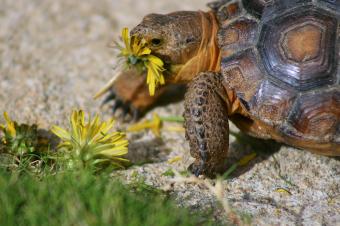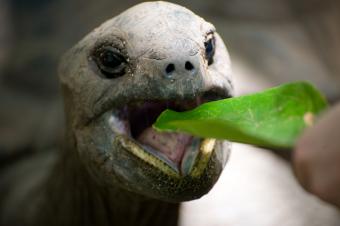
Although it may concern you as a first-time turtle owner, it's actually normal for a turtle to not eat for a few days. If they have stopped eating for several days, it's time to look at what's going on in their environment to see if there's a problem. Many times there's no problem at all, but it's always good to be on the safe side. If your turtle goes more than a few days without eating, there may be a concern, and it's important to understand what could be causing their lack of appetite.
Reasons for a Turtle's Lack of Appetite
Before you attempt to coax your turtle to eat, it's important to figure out why they're not eating. Changes in their environment, feeding schedule, and diet can all be possible causes.
Stress
If you've just brought your new turtle home, they may be very stressed at all the changes in their environment. If you have been handling your turtle a lot, this may also cause stress. Aquarium setup and maintenance expert Austin Weber of Lucky Pup Adventures says, "turtles are not a creature that, in their ideal world, you are handling them every day. If you want a turtle that is ok with more handling, tortoises are a better choice. Aquatic turtles are not keen on being touched a lot." Weber also said stress can come from poor water quality and poor lighting.
Temperature

Since turtles require their environments to be a certain temperature, if your aquarium is not warm enough, this can dampen their appetite. Like many reptiles, a turtle should have areas of his tank with different temperatures that they can move about in as they please. The proper temperature varies depending on the species of turtle. For example:
- A box turtle needs a basking area of 80 to 90 degrees Fahrenheit and a cool area of 70 to 80 degrees during the day. It can be no cooler than 60 degrees in the evening.
- An adult red-eared slider turtle needs water in his tank for swimming kept at 75 to 80 degrees Fahrenheit. Younger turtles need the water at 80 to 85 degrees. The basking area during the day should be 85 to 90 degrees with a heat lamp turned off in the evening.
Appropriate Lighting
Just as with temperature, it's important to provide species-appropriate lighting in your turtle's enclosure. Most types of pet turtle species require about 12 to 14 hours of light each day, followed by a night cycle of about 10 to 12 hours. Weber notes that turtles need UVB lighting to process nutrients properly and the lack of it can make them lethargic and lose their appetite.
Illness
The first thing you should do is look over your turtle for signs of illness. Some common symptoms of sickness are:
- Wheezing, sneezing, difficulty breathing, and discharge from the nose and eyes that appear irritated and swollen, along with lethargy indicate a possible respiratory infection.
- Discolored areas on the shell can be caused by a lack of vitamin A in their diet.
- If you do not see any feces in the tank and don't see them eliminating, they may be constipated.
- If your turtle's feces has signs of worms, he may have a parasitic infection that is dampening their appetite.
- If the turtle is female and has stopped eating, it's possible she has dystocia, which means she cannot properly pass her eggs out of the body. Turtles with dystocia can seem fine at first, other than lack of appetite, but will develop lethargy and lose weight over a short period of time.
Diet

It's possible your turtle isn't eating because of his diet. Weber suggests to turtle owners, "Try and vary their diet. You can try something different to stimulate their appetite." If you've fed them primarily a commercially prepared turtle diet, they may do better eating live food like crickets, snails, mealworms, and earthworms. Some turtles will even eat small feeder mice or feeder fish. Some other changes you can make to their diet to help them eat include:
- Adding fresh food to their diet like mushrooms, cucumbers, tomatoes, collard greens, carrots, and leafy vegetables like lettuce, arugula, spinach, and cabbage.
- Add small quantities of fresh fruit such as strawberries, raspberries, bananas, watermelon, grapes, melon, papaya, or mangoes.
- Turtles are attracted to bright colors, so, in addition to fruit, some will respond favorably to rose petals and dandelions.
- Soaking dry turtle food in a fruit juice, non-caffeinated sports drinks, or the water from canned tuna.
- If live insects aren't an option, you can also try canned insects. Some turtles may also enjoy small pieces of cooked bland chicken, beef, freshwater fish, or boiled egg whites.
Use Water
Some species of turtles do better eating their meals underwater. You can experiment with putting his food in the watery area of his tank to see if this sparks his appetite. Another way to use water to entice your turtle to eat is to fill a spray bottle and gently mist them. The reason for this is turtles instinctually will try to eat when it's raining because in the wild they know this is when worms are more easily accessible.
Lack of Calcium
Another dietary issue that can affect your turtle's appetite is not getting enough calcium. If your turtle isn't getting a calcium supplement in addition to their regular diet, you can provide them with one through a weekly sprinkling of calcium powder on their food. Cuttlebones and calcium blocks in their tank are also good options.
Time of Day

Turtles tend to have better appetites when they're most active, which is either early in the day or later in the afternoon. If you've been feeding them midday or in the evenings when they're more sluggish, try changing the time of day to see if this stimulates their appetite. The closer you can feed them to the start of the day at dawn, the better, though this will mean some early morning alarm-setting for you! Adult turtles also do not need to eat every day, so it's possible they simply aren't hungry if you're giving them food daily instead of every other day.
Time of Year
Some turtles will attempt to brumate in the fall and during the winter. If you can find nothing wrong with your turtle's health, discuss the possibility that he is trying to hibernate with your veterinarian. Brumation may not be recommended by your veterinarian, as it can cause additional medical issues for your turtle. Even if your turtle doesn't fully brumate in the winter, Weber says it's normal for them to eat less and be less active at this time of year.
Time for the Veterinarian
If you are able to figure out the cause behind your turtle's lack of appetite and make simple adjustments to their tank environment or diet, you hopefully should be back on track with feeding them regularly. If your turtle hasn't eaten in a week or if you notice signs of illness coupled with a lack of appetite sooner than a week's passing, it's time to get your turtle to a reptile veterinarian. Although a turtle can actually go without food for weeks, you don't want to delay getting them treatment if the cause is an underlying medical problem.







